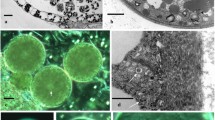Summary
-
1.
Merosporangia are initiated as simple evaginations of the ampulla wall. As merosporangia elongate, two new wall layers are deposited. Plasmalemmasomes are associated with developing walls of both ampullase and merosporangia.
-
2.
Apical vesicles are present in merosporangia at all stages of elongation. Similar vesicles, and cisternae sometimes containing material having the same stainability as vesicle contents, are present in the ampulla.
-
3.
In merosporangia in mid cleavage, the cleavage apparatus consists of furrows extending into the protoplast. Furrows are bounded by a membrane continuous with the ampulla plasmalemma and contain a lining layer of either granular or continuous appearance according to fixation.
-
4.
Delimited spore protoplasts are bounded by a plasmalemma derived in part from the merosporangium plasmalemma and in part from cleavage furrow bounding membranes and are surrounded by an investing layer derived from the cleavage furrow lining.
-
5.
The spore wall is laid down between the plasmalemma and the investing layer which thickens as the wall develops.
-
6.
As sporangial heads mature, spores round off and spore walls thicken, the innermost layer of the ampulla wall and merosporangium wall is broken down, a new wall is formed internal to the ampulla wall and, in some heads, a cross wall is formed in the sporangiophore.
Similar content being viewed by others
References
Barer, R., Joseph, S.: Refractometry of living cells. II. The immersion medium. Quart. J. micr. Sci. 96, 1–27 (1955).
Benjamin, R. K.: The merosporangiferous Mucorales. El Aliso 4, 321–453 (1959).
Bonnett, H. T., Newcomb, E. H.: Coated vesicles and other cytoplasmic components of growing root hairs of radish. Protoplasma (Wien) 62, 59–75 (1966).
Bracker, C. E.: The ultrastructure and development of sporangia of Gilbertella persicaria. Mycologia (N.Y.) 60, 1016–1067 (1968).
Bracker, C. E.: Cytoplasmic vesicles in germinating spores of Gilbertella persicaria. Protoplasma (Wien) 72, 381–398 (1971).
Brenner, D. M., Carroll, G. C.: Fine structural correlates of growth in hyphae of Ascodesmis sphaerospora. J. Bact. 95, 658–671 (1965).
Gay, J. L., Greenwood, A. D.: Structural aspects of zoospore production in Saprolegnia ferax with particular reference to the cell and vacuolar membranes. In: The fungus spore, pp. 95–108, M. F. Madelin, ed. London: Butterworths 1966.
Gay, J. L., Greenwood, A. D., Heath, I. B.: The formation and behaviour of vacuoles (vesicles) during oosphere development and zoospore germination in Saprolegnia. J. gen. Microbiol. 65, 233–241 (1971).
Girbardt, M.: Die Ultrastruktur der Apicalregion von Pilzhyphen. Protoplasma (Wien) 67, 413–447 (1969)
Grove, J. N., Bracker, C. E.: Protoplasmic organisation of hyphal tips: vesicles and spitzenkörper. J. Bact. 104, 989–1009 (1970).
Grove, J. N., Bracker, C. E., Morré, D. J.: An ultrastructural basis for hyphal tip growth in Pythium ultimum. Amer. J. Bot. 57, 245–266 (1970).
Hawker, L. E., Gooday, M. A.: Fusion, subsequent swelling and final dissolution of the apical walls of progametangia of Rhizopus sexualis (Smith) Callan. New Phytol. 68, 133–140 (1969).
Heath, I. B., Gay, J. L., Greenwood, A. D.: Cell wall formation in the Saprolegniales: cytoplasmic vesicles underlying developing walls. J. gen. Microbiol. 65, 225–232 (1971).
Heath, I. B., Greenwood, A. D.: The structure and formation of lomasomes. J. gen. Microbiol. 62, 129–137 (1970).
Hemmes, D. E., Hohl, H. R.: Ultrastructural changes in directly germinating sporangia of Phytophthora parasitica. Amer. J. Bot. 56, 300–313 (1969).
Hesseltine, C. W.: A survey of the Mucorales. Trans. N.Y. Acad. Sci. Ser. 2, 14, 210–214 (1952).
Hohl, H. R., Hamamoto, S. T.: Ultrastructural changes during zoospore formation in Phytophthora parasitica. Amer. J. Bot. 54, 1131–1139 (1967).
Karnovsky, M. J.: A formaldehyde-glutaraldehyde fixative of high osmolarity for use in electron microscopy. J. Cell Biol. 27, 137A-138A (1965).
Lessie, P. E., Lovett, J. S.: Ultrastructural changes during sporangium formation and zoospore differentiation in Blastocladiella emersonii. Amer. J. Bot. 55, 220–236 (1968).
Marchant, R., Robards, A. W.: Membrane systems associated with the plasmalemma of plant cells. Ann. Bot. (N.S.) 32, 457–471 (1968).
McClure, W. K., Park, D., Robinson, P. M.: Apical organisation in the somatic hyphae of fungi. J. gen. Microbiol. 50, 177–182 (1968).
McCully, E. K., Bracker, C. E.: Apical vesicles in growing bud cells of Heterobasidiomycetous yeasts. J. Bact. 109, 922–926 (1972).
Moore, R. T., McAlear, J. H.: Fine structure of Mycota. 5. Lomasomes — previously uncharacterised hyphal structures. Mycologia (N.Y.) 53, 194–200 (1961).
Moreau, F.: Recherches sur la reproduction de Mucorinées et de quelques autres Thallophytes. Botaniste 13, 1–136 (1913).
Reynolds, E. S.: The use of lead citrate at high pH as an electron opaque stain in electron microscopy. J. Cell. Biol. 17, 208–212 (1963)
Rosen, W. G., Gawlik, S. R., Dashek, W. V., Siegesmund, K. A.: Fine structure and cytochemistry of Lilium pollen tubes. Amer. J. Bot. 51, 61–71 (1964).
Sentandreu, R., Northcote, D. H.: The formation of buds in yeast. J. gen. Microbiol. 55, 393–398 (1969).
Sievers, A.: Elektronenmikroskopische Untersuchungen zur geotropischen Reaktion. II. Die polare Organisation des normal wachsenden Rhizoids von Chara foetida. Protoplasma (Wien) 64, 225–253 (1967).
Thaxter, R.: Contributions from the cryptogamic, laboratory of Havard University. XL. New or peculiar Zygomycetes. 2. Syncephalastrum and Syncephalis. Bot. Gaz. 24, 1–15 (1897).
Author information
Authors and Affiliations
Rights and permissions
About this article
Cite this article
Fletcher, J. Fine structure of developing merosporangia and sporangiospores of Syncephalastrum racemosum . Archiv. Mikrobiol. 87, 269–284 (1972). https://doi.org/10.1007/BF00409129
Received:
Issue Date:
DOI: https://doi.org/10.1007/BF00409129




